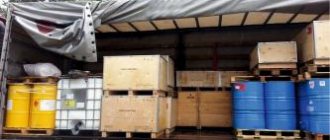Propane is most often called a mixture consisting of butane and propane. Impurities of other gases may be present, but they are insignificant. The peculiarity of propane is that it has neither odor nor color. This is quite dangerous, because it is difficult to establish and prevent the fact of a leak, which can lead to serious consequences. Therefore, an odorant substance, which has a pungent odor, is often added to the mixture. Propane is obtained during oil refining or during the extraction of petroleum gases. Propane is widely used in metallurgy and is also used as fuel. The mixture is transported in steel cylinders providing a pressure of 16 atmospheres.
- 2 Rules for safe handling of propane cylinders during transportation
- 3 Video: consequences of poorly secured gas cylinders
- 4 Video: how to safely disassemble a gas cylinder
- 5 How many cylinders can be transported?
- 6 Necessary documentation for transporting propane
General rules for transporting propane in cylinders
In order to avoid errors during transportation, the following conditions must be met:
- a vehicle transporting propane must be tested for the ability to transport dangerous goods, the vehicle must also be equipped with fire safety equipment and have signs on its sides warning about the transportation of explosive goods;
- care must be taken to draw up appropriate documentation permitting the transportation of propane in cylinders so that government authorities have the opportunity to verify compliance with the rules for the transportation of dangerous goods;
- Explosion warning stickers must be placed on the cylinders;
- the driver must be instructed in safety rules and be certified to transport propane cylinders.
Vehicle for transporting propane in cylinders
Propane cylinders intended for transportation should be stored in specially prepared places away from heaters, electrical wires and fire. When loading cylinders into a car in an open space, heating by the sun's rays should be avoided, so gas containers should be placed in the shade. Failure to comply with this rule can lead to tragedy. The minimum distance that can be between containers with propane and lubricants, oil and paint is 6 meters.
To avoid the possibility of falling, gas cylinders in the vehicle must be positioned horizontally. But in the case of propane, transportation in a vertical position without a container is allowed if gaskets are used between the cylinders and a special fence that protects against falling. Empty cylinders cannot be transported together with full ones.
Is transportation of gas cylinders allowed?
Transportation of propane, oxygen, as well as argon and some other gases in compressed form in a passenger car is permitted. But there are many caveats that must be observed. This is due to the fact that compressed oxygen, like other gases, being under high pressure, is a cargo classified as dangerous. The legal right to such transportation is fixed in the Decree of the Government of the Russian Federation dated April 15, 2011 N 272 (as amended on December 22, 2016) “On approval of the Rules for the carriage of goods by road” and the European Agreement on the International Carriage of Dangerous Goods by Road (ADR/ADR) (concluded in Geneva 09/30/1957).
These documents allow you to determine how many gas cylinders can be transported without a permit, depending on the category of their contents. And the clarification issued by the Road Safety Department of the Ministry of Internal Affairs of Russia (No. 13/2–121 dated July 26, 2006) specifies the possibility of transporting compressed argon, dissolved acetylene, compressed oxygen and propane, contained in cylinders with a capacity of 50 liters. without complying with the requirements of the Rules for the Transportation of Dangerous Goods by Road.
A positive or negative answer to the question of whether a gas cylinder can be transported in a passenger car depends on a number of factors. These are: the contents of the gas cylinder, the “neighborhood” in which it will have to be during transportation, the placement and fixation of gas cylinders in the car, etc. There is a set of rules regulating the possibility of transportation in each specific case.
Rules for the transportation of gas cylinders
Before thinking about how to transport a gas cylinder in a passenger car, you need to make sure that it is in good working order and take care to avoid suspicion of breaking the law on the part of traffic police officers. To do this, after filling the container with compressed gas, it must be checked for leaks. And each filled gas cylinder must be marked in the form of an inscription containing the name of the transported gas and its danger signs. The basic rules for transporting gas cylinders are as follows:
- before starting transportation, it is necessary to check the integrity of the gas cylinder, its plugs and fittings;
- transportation of gas cylinders by road is permissible only in the trunk of a vehicle, but not in the passenger compartment;
- In the trunk of a car, each container with compressed gas should be firmly fixed so as to avoid the possibility of its movement. For this purpose, it is permissible to use rope fastenings, wooden blocks with sockets of appropriate sizes, and rubber rings. The choice in favor of one or another means of fastening should primarily depend on the quality of the road surface;
- The location of gas cylinders in the car must be horizontal, each row can consist of no more than 3 units. The total number of containers (and their weight) must not exceed the maximum permissible load capacity of the vehicle. The direction of location of gas cylinder valves is towards the passenger compartment;
- there should be no objects in the trunk, the movement of which while the car is moving could lead to impacts on gas cylinders;
- It is prohibited to transport explosive and/or flammable objects together with gas cylinders in the trunk of a car.
Additional restrictions that must be observed to prevent a gas cylinder from exploding in a vehicle:
- it is prohibited to exceed the maximum permissible rate for filling a cylinder with compressed gas;
- It is not recommended to transport gas cylinders on hot summer days, since compressed gases may react to excessive temperature increases outside the containers;
- Do not smoke in the immediate vicinity of a car loaded with compressed gas cylinders;
- It is prohibited to stop the vehicle near places where objects are on fire (i.e. open flames).
If you intend to transport propane, then you must separately familiarize yourself with the rules regarding the transportation of this particular gas in a compressed state. When moving gas cylinders, a passenger car should not be left unattended. The driver of the vehicle must try to drive it without sudden changes in speed and avoid driving at high speeds. Unloading of gas cylinders delivered to their destination (as well as their loading before transportation) must be carried out carefully, avoiding impacts and sudden movements.
Rules for safe handling of propane cylinders during transportation
Loading propane cylinders
Persons involved in loading may only handle cylinders with clean hands. To avoid the cylinder slipping, it is recommended to use clean gloves or a rag. This will prevent sand or grease from contaminating the valve nozzle. It is better to move cylinders from the warehouse to the car using carts designed for this purpose. Propane cylinders must not be dragged. When loading gas containers using lifting mechanisms, care should be taken to securely secure the cylinders to avoid falling.
In the case of propane transportation, negligence is punished especially severely! Here we are not talking about fines or banal loss of cargo, which entailed only financial losses. The consequences of ignoring safety rules can lead to a real emergency.
External transportation
The degree of industrial hazard of the gas with which the cylinder is filled, as well as the time, temperature conditions and transportation distance are taken into account. When using vehicles, pay attention to the following:
- The car must be specialized, and the driver must have the required form of permission;
- The vehicle must undergo appropriate routine maintenance;
- Transportation must be carried out only with the necessary accompanying documents.
If gas cylinders containing a particularly toxic substance are transported, the safest route for its transportation must be drawn up. When crossing the highway with busy highways, the traffic police are involved in ensuring safety conditions.
Similar articles
- Cylinder installations: application
- The design of the gas cylinder and signs of its malfunction
- Gas cylinders for cars
Video: consequences of poorly secured gas cylinders
When loading and unloading propane cylinders, the following rules should be followed:
- It is forbidden to work alone, at least 2 people can participate;
- You cannot carry cylinders on your arms or on your shoulder;
- cylinders should be loaded and unloaded in such a way that they do not hit each other or hit the ground;
- It is prohibited to hold and feed cylinders with the valve down;
- cylinders must have caps and plugs;
- it is necessary to protect the cylinders from rust and oxidation;
- during transportation, the cylinders must be secured to a rigid base;
- tightening the protective caps should be done by hand to avoid sparks;
- the temperature of the propane cylinder during transportation should not exceed 45 degrees Celsius;
- transporting propane and oxygen in the same car is strictly prohibited;
In order to disassemble a gas cylinder, you must also follow safety precautions. First, you need to make sure that the cylinder is empty. Then remove the protective caps and valve to fill the cylinder with approximately 30 liters of warm water. Only after this can the cylinder be cut to use it for your own purposes. Inventive citizens use a disassembled cylinder, for example, as a barbecue. Sometimes homemade heaters are made from it.
Features of lifting and transportation in the warehouse
Lifting gas cylinders (whether empty or full) should only be carried out using powered lifting vehicles that have locking units - brakes, latches, clamps, ratchets, etc. The method of operation of such devices is exclusively mechanical, since otherwise (for example, the presence of a pneumatic or hydraulic drive), a sudden cessation of the energy supply can lead to an accident.
For lifting, it is prohibited to use homemade grips, but only suitable cradles, slings, clamps or other effective means that are equipped with lifts or cranes. Under no circumstances should cylinders be lifted by parts of the valves, casings or caps.
Front-end forklifts are among the vehicles commonly used in warehouses. It is prohibited to use such equipment for transporting gas cylinders, since the forks cannot stably fix the container while the forklift is moving.
The transportation procedure is as follows:
- Before starting work, put protective caps or lids on the neck of the gas cylinder.
- When moving cylinders in groups, they must all be installed in a vertical position and securely connected to each other.
- Regulators and hoses are disconnected whenever possible (this does not affect the quality of transportation, but creates inconvenience for operating personnel).
- Cylinders must not protrude beyond the dimensions of the loader platform.
- When delivering to your final destination, it is recommended to double-check the labeling of gas cylinders to avoid confusion.
In some cases, additional precautions are provided.
The type of ground transport does not affect the safety of transporting gas cylinders; it can be either electric or forklifts.
How many cylinders can be transported?
At the legislative level, the transportation of 15 propane cylinders in one vehicle does not apply to the transportation of dangerous goods. Propane has the smallest amount among other gases. The table shows comparative indicators of the maximum number of cylinders of different gases, at which the standards for the transportation of dangerous goods do not apply:
| Gas name | Group | Tara | Quantity |
| Argon | 2A | 40 liter cylinder | 24 pieces are allowed to be transported |
| Helium | 2A | 40 liter cylinder | 24 pieces are allowed to be transported |
| Carbon dioxide | 2A | cylinder weighing 24 kilograms and volume 40 liters | 41 pieces are allowed to be transported |
| Carbon dioxide | 2A | cylinder weighing 19 kilograms and volume 40 liters | 52 pieces are allowed to be transported |
| Nitrogen | 2A | 40 liter cylinder | up to 24 pieces inclusive |
| Oxygen | 2O | 40 liter cylinder | 24 pieces are allowed to be transported |
| Acetylene | 2F | A cylinder weighing 5 kilograms and volume 40 liters | 18 pieces are allowed to be transported |
| Propane | 2F | A cylinder weighing 21 kilograms and volume 50 liters | 15 pieces are allowed to be transported |
Class “A” includes neutral gases, “O” – oxidizing, “F” – flammable.
Regulatory regulation of liquefied gas transportation
The transport of dangerous liquefied gases is regulated by the Agreement on the International Transport of Dangerous Goods (ADR, ), which has been in force since 1957 in the European Union and other countries that have joined its implementation. In addition, the transportation of liquefied gas by road is regulated by the following Russian regulatory documents:
- Decree of the Government of the Russian Federation dated April 15, 2011 No. 272;
- Directive of the Department for Ensuring Safe Traffic of the Ministry of Internal Affairs dated July 26, 2006 No. 13/2-121;
- Traffic rules, articles 2.1, 3.4, 23.4;
- GOST 19433-88 on classification and labeling of dangerous goods.
In this case, international ADR takes priority, which has been repeatedly explained by ministries and departments in letters and other documents.











